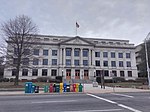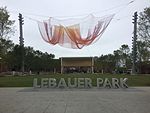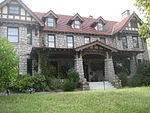Summit Avenue Historic District

Summit Avenue Historic District, also known as the Dunleath Historic District and formally as the Charles B. Aycock Historic District, is a national historic district located at Greensboro, Guilford County, North Carolina. The district encompasses 226 contributing buildings in a middle- and upper-class residential section of Greensboro. The houses were largely built between the 1890s and 1930s and include notable examples of Queen Anne, Colonial Revival, American Foursquare, and Bungalow / American Craftsman-style architecture. The Sigmund Sternberger House (1926) is listed separately. Other notable buildings include the John C. Clapp House (c. 1900-1905), Robert L. Potts House (c. 1900-1905), William B. Vaught House (c. 1906), Edgar B. Jennette House (c. 1925-1930), and the Charles B. Aycock School (1922) designed by Starrett & van Vleck.It was listed on the National Register of Historic Places in 1993.
Excerpt from the Wikipedia article Summit Avenue Historic District (License: CC BY-SA 3.0, Authors, Images).Summit Avenue Historic District
Cypress Street, Greensboro
Geographical coordinates (GPS) Address Nearby Places Show on map
Geographical coordinates (GPS)
| Latitude | Longitude |
|---|---|
| N 36.081666666667 ° | E -79.781944444444 ° |
Address
Cypress Street 168
27405 Greensboro
North Carolina, United States
Open on Google Maps










